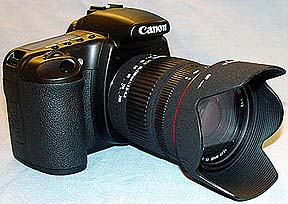

Why I Purchased a Canon EOS 20D: An evaluation of needs, budget, and capabilities in deciding which camera to purchase.
For two years I'd been using a Sony DSC F707 5 megapixel camera, a glorified point-and-shoot. While it opened my interest in photography, it's inability to accept alternate lenses, slow shutter speed, aperture limitations and many other issues prevented me from doing many of the things I wanted to do. It was time for a new camera. This time a good one.
The first consideration was what I was going to use the new camera for. Looking back over the last year's worth of pictures I'd taken, I discovered that my primary interest was in macro, or micro, photography. (For example, I'm more likely to want to take a picture of an aphid on a flower than of the flower itself.) This demands that the camera has to be able to support macro lenses (almost all SLR cameras do) and have the largest possible pixel count. The reason for the later is that I had learned that in macro photography it's not unusual to end up throwing away 90 percent of the frame to crop down to the small bit you want. To do so and still have enough pixels left to create a reasonably sharp print means you have to start with as many as possible.
The second consideration was budget. While it would be nice to be able to purchase the highest pixel-count camera on the market, which in the 35mm-class of camera I believe may be the Canon EOS 1Ds Mark II 17.2 megapixel monster, it's $8,000 price tag was way over my head. At $5,000 the Nikon 11 megapixel camera was also too much money. The next contenders were in the 6-8 megapixel range and cost $1400 to $1000 respectively. After reviewing many reviews about cameras in this class, the two that ended up in the selection finals were the Nikon 70D (6.1 megapixels for $1000 - body only) and the Canon 20D (8.2 megapixels for $1400 - body only.) Each had advantages: the Nikon felt better in-hand, was slightly faster, quieter, was cheaper and best off all my brother, who's forgotten more about photography than I'll ever know, had one so I'd have a good source of instruction. On the other hand the Canon provided 33-percent more pixels and had the psychological advantage of driving my brother crazy if I got a Canon over a Nikon. (Please see COMPARING THE CANON 20D TO THE NIKON D70 for a more complete list of the touchy-feely issues for these two cameras.)
All in all the race was too close to call.
In the end it was the availability of one particular lens that decided the outcome. Canon makes a unique 65mm 1x-5x macro photo lens that would be ideal for the kind of work I want to do. That, and the higher pixel count, broke the tie for me and was well worth the higher cost. (And oh yes, my brother cringes when I enter his house carrying a Canon instead of a Nikon.)

For general use I got a Sigma 18-200mm lens with a close focus of 17.7 inches at all focal lengths. (Actually, the near-focus working distance from the front of the lens to the subject is 6.5 inches and the distance from the object to the sensor is only 13 inches. I don't know where the 17.7 inches came from.)
The camera works great and though there is a lot about it I still don't understand, even after reading the manual twice, I'm thoroughly enjoying it.
Two weeks after buying the Canon 20D - the honeymoon's over:
After using the Canon for two weeks I'd like to add a couple of comments about it. At first I felt the grip was too shallow causing my fingertips to jam into the body. It turns out that in use the hand holds the camera at such an angle that the fingertips point slightly downward and don't touch the body. Second, at least as far as I've been able to read from the manual, the built-in flash is slaved to the shutter so that it's impossible to shoot any faster than 1/250 second. While there may be good technical reasons for having it this way, I would have appreciated a full manual option that allows me to use the flash at any shutter speed, even if the picture wouldn't turn out.
I also wish the exposure information would remain on longer in the viewfinder after half-pressing the shutter release. Many times it blinks off before I've made all the changes I want.
The LCD is far too dim to observe pictures outside. Text is slightly better but is still very weak. A good solution would be to develop a way to have a second smaller LCD screen that could be projected through the viewfinder on demand.
The shutter is unpardonably loud. I take a lot of close-up pictures of hummingbirds and it repeatedly scares them away.
Developing the option to use the LCD as a viewfinder that shows what the exposure will look like when the picture is taken would be a great, though admittedly complex, addition to the camera. The Sony 707 has it and it's very convenient.
UPDATE!!!
Since writing this page I've upgraded several times and now use a Canon 6D
Return
to the mainpage and browse 90 other
subjects including several other pages related to cameras, lenses and photography.